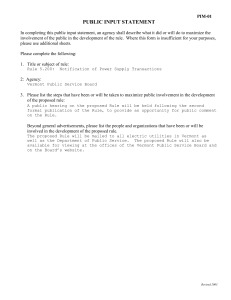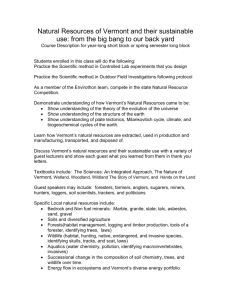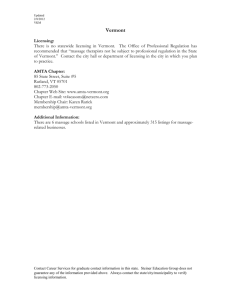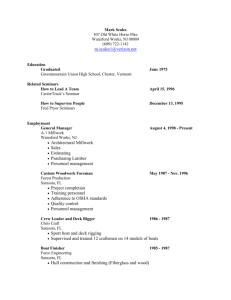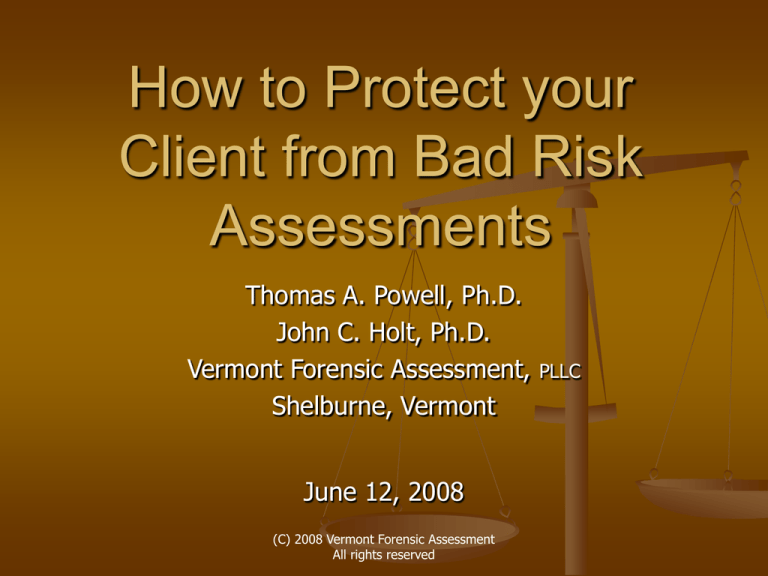
How to Protect your
Client from Bad Risk
Assessments
Thomas A. Powell, Ph.D.
John C. Holt, Ph.D.
Vermont Forensic Assessment,
Shelburne, Vermont
June 12, 2008
(C) 2008 Vermont Forensic Assessment
All rights reserved
PLLC
Outline
How things are supposed to work
Static and dynamic measure of any type of
criminal recidivism and offender needs
Level of Service Inventory - Revised
Assessment perspective
Risk principle
Need principle
Responsivity principle
(C) 2008 Vermont Forensic Assessment
All rights reserved
Outline
Static actuarial measures of sexual recidivism
risk
STATIC-99
RRASOR
VASOR
Dynamic measures of sexual recidivism risk
SONAR
STABLE/ACUTE
Treatment Progress Scale
(C) 2008 Vermont Forensic Assessment
All rights reserved
Outline
Additional topics of interest
The use of multiple risk instruments: Static 99,
RRASOR and VASOR as policy
“Denial” - a misleading predicator of recidivism.
Conflict of interest by assessors and treatment
providers.
The DOC case staffing: Salem Witch Trials redux?
(C) 2008 Vermont Forensic Assessment
All rights reserved
QuickTime™ and a
TIFF (Uncompressed) decompressor
are needed to see this picture.
(C) 2008 Vermont Forensic Assessment
All rights reserved
How Things are Supposed to Work
PSI preparation - Policy 342.01
(rev. 4/9/07)
http://doc.vermont.gov/about/policies/rpd/fin
al_commissioner-signed_psi_3.22.07.pdf
Prescriptive format
Defines LSI-R as “an objective, quantifiable
instrument that provides a consistent and
valid method of predicting risk to re-offend
and a reliable means of measuring offedner
change over time …”
(C) 2008 Vermont Forensic Assessment
All rights reserved
How Things are Supposed to Work
RRASOR: “a four-item actuarial risk measure
used to aid in assessing sexual recidivism risk …”
Static-99: “… a 10-item actuarial risk measure is
used in a similar manner as the RRASOR.”
VASOR: “a risk assessment scale … designed to
assist PO’s in making placement and supervision
decisions.”
(C) 2008 Vermont Forensic Assessment
All rights reserved
How Things are Supposed to Work
“A PSI provides the sentencing judge … with
relevant information on which to base a
sentencing decision. It also reflects a
professional judgment of and assessment by the
DOC regarding risk management of the
defendant.”
“The PSI investigator can use information
collected during the PSI, particularly during the
defendant interview, to complete necessary risk
assessment tools, e.g. the LSI-R.”
(C) 2008 Vermont Forensic Assessment
All rights reserved
How Things are Supposed to Work
“Provide a narrative explanation of the numerical results
of assessment tools (e.g. LSI-R), including an
examination of key risk areas and a summary of any
court-ordered clinical assessments.”
“Briefly summarize the major points of the report …”
“The report will conclude with a recommendation …
based upon the defendant’s offense, background and
assessed risk.”
(C) 2008 Vermont Forensic Assessment
All rights reserved
How Things are Supposed to Work
“Note: Only if requested by the Court, the
PSI investigator will include a recommended
minimum and maximum term of incarceration or
a minimum and maximum term of suspended
sentence.” (emphasis not added by us)
(C) 2008 Vermont Forensic Assessment
All rights reserved
General Risk Assessment
Level of Service Inventory - Revised
Criminal History
Education/Employment
Financial
Family/Marital
Accommodation (the influence of address)
Leisure/Recreation (spare time use)
Companions (friends and associates)
Alcohol/Drugs (mostly looking at past year)
Emotional/Personal (psychological status)
Attitudes/Orientation (antisocial/prosocial views)
(C) 2008 Vermont Forensic Assessment
All rights reserved
ASSESSMENT PERSPECTIVE
Prediction
2
Environmental
Contingencies
Assessment
1
Behavior
Psychological
Predisposition
Time
1:
Primary objective is to understand factors linked to future behavior
2:
Ultimate assessment objective is to estimate future behavior
Simourd, D.J. (1999, May), On a general forensic evaluation model: A practical
framework for offender assessment. Paper presented at the annual meeting of the
Canadian Psychological Association, Halifax, N.S.
Risk Principle
1.
2.
3.
Reserve intensive levels of corrections
supervision and treatment for higher
risk cases.
Do not use these levels of supervision
and treatment for lower risk cases.
Use of valid and reliable risk
assessment tools gives the criminal
justice system a triage capability.
(C) 2008 Vermont Forensic Assessment
All rights reserved
Need Principle
1.
2.
3.
4.
There are many needs and potential treatment
targets identified in corrections populations.
Some are related to criminal risk; some are
not.
Focus on those needs which are “criminogenic”
(ie. causally related to crime) such as social
affiliations, drugs and criminal attitudes.
When criminogenic needs are addressed, the
risk of recidivism declines.
(C) 2008 Vermont Forensic Assessment
All rights reserved
Responsivity Principle
1.
2.
3.
4.
When providing treatment services for forensic or
corrections populations, use methods which are
matched to the learning style of the population.
Cognitive-behavioral, skill-building, and relapse
preventing interventions fit this model.
Non-directive, non-specific “talk therapy” methods do
not.
The use of appropriate intervention models lowers
risk; other models have either no effect on recidivism
or they may actually raise it.
(C) 2008 Vermont Forensic Assessment
All rights reserved
Sex Offense Specific Measures
Static Actuarial Measures
RRASOR
Static-99
VASOR
Dynamic/Treatment Measures
SONAR
STABLE/ACUTE
Sex Offender Treatment Needs and Progress
Scale
(C) 2008 Vermont Forensic Assessment
All rights reserved
RRASOR
Rapid risk assessment of sex offender
recidivism
ww2.ps-sp.gc.ca/publications/corrections/
199704_e.pdf
Four item scale
All four are incorporated into the STATIC-99
Total score 0-6
0
1,2
3,4
5,6
Low
Moderate-Low
Moderate-High
High
(C) 2008 Vermont Forensic Assessment
All rights reserved
RRASOR - Rapid risk assessment of sex
offender recidivism
STATIC-99
Ten item scale
Total score 0-12
0,1
2,3
4,5
6+
Low
Moderate-Low
Moderate-High
High
(C) 2008 Vermont Forensic Assessment
All rights reserved
STATIC-99
Widely used in criminal, forensic and
correctional settings.
Instrumental in most sexually violent
predator (SVP) determinations.
Not as easy to score as it seems. Many
scoring rules to understand.
(C) 2008 Vermont Forensic Assessment
All rights reserved
STATIC-99
The Static-99 scoring manual is 80 pages
long.
http://ww2.pssp.gc.ca/publications/corrections/pdf/Static99-coding-Rules_e.pdf
Or google “Static-99”
(C) 2008 Vermont Forensic Assessment
All rights reserved
STATIC-99 Issues
Like most actuarial risk assessment
instruments, it is only +/- 70% accurate.
False positives - over-predicting risk
False negatives - under-predicting risk
Over-reliance on unchanging static risk factors
to the exclusion of changing dynamic risk
factors is a significant problem in Vermont
(and elsewhere).
(C) 2008 Vermont Forensic Assessment
All rights reserved
STATIC-99 - age and recidivism
STATIC-99 - age and recidivism
“There were few sexual offenders
of any type in the advanced age
category (>50 years !!) … and
their recidivism rates were
generally low.”
• decreasing sex drive
• fewer opportunities
Hanson, K.W. (2002). Recidivism and age. Journal of Interpersonal
Violence, 17 (10), 1046-1062.
STATIC-99 - time at risk
Listserv communication from Hanson and
Harris (3/10/08)
“Recently, (we) found follow-up recidivism
rates to be below that which would be
expected given those found in the original
STATIC-99 samples of origin. This has led
to some question as to whether there has
been a shift in the nature of sexual
recidivism and whether the estimates
generated from the samples of origin are
still valid.”
VASOR
Vermont assessment of sex offender risk
Weighs 19 variables
13 on the Reoffense Risk Scale
6 on the Violence Scale
According to the manual, scores are
plotted on an overall risk chart
Reoffense Risk Scale x Violence Scale
(C) 2008 Vermont Forensic Assessment
All rights reserved
VASOR
Prior sex offenses
Prior adult convictions
Court order violations
Force used during current
arrest
Relationship to victim
Male victim
History of exhibitionism
Deviant sexual fixation
Alcohol of drug use (past five
years)
Address changes (past year)
Time employed/ in school
Past treatment success
Amenability to treatment
Prior convictions for violent
crimes
Prior conviction for crime
involving deadly weapon
Force used during current
offense
Sexual intrusiveness of current
offense
Physical harm to victim
Victim <5, >55, or
handicapped
(C) 2008 Vermont Forensic Assessment
All rights reserved
VASOR - Daubert criteria issues
No
peer-reviewed studies on its reliability
and validity
Manual relies on studies presented in
poster format
Manual clearly marks the VASOR as a
“research version”
Not cited in major reviews of other
actuarial scales
Used rarely outside of Vermont
(C) 2008 Vermont Forensic Assessment
All rights reserved
VASOR - Validity issue
According to Georgia Cumming, new cases
are being added to the VASOR database,
and within “a couple of weeks” there will
be new cut points for describing the risk
level of cases, based on their scores.
(C) 2008 Vermont Forensic Assessment
All rights reserved
Dynamic Measures of Sexual
Recidivism Risk
SONAR: Sex offender need assessment rating
Stable 2007 and Acute 2007
Treatment Progress Scale (Vermont-specific)
(C) 2008 Vermont Forensic Assessment
All rights reserved
SONAR - sex offender needs assessment
rating
rates dynamic factors related to recidivism
improves the predictive accuracy and utility
of actuarial (historical factors) instruments
by considering changing circumstances in
the offender’s life (ie. dynamic factors)
http://ww2.pssp.gc.ca/publications/corrections/200001b_e
.asp
(C) 2008 Vermont Forensic Assessment
All rights reserved
Stable and Acute - 2007
Stable factors
Significant social influences
Capacity for relationship stability
Emotional identification with children
Hostility toward women
General social rejection
Lack of concern for others
Impulsive
Poor problem solving skills
(C) 2008 Vermont Forensic Assessment
All rights reserved
Stable and Acute - 2007
Stable factors (cont.)
Negative emotionality
Sex drive preoccupation
Sex as a coping mechanism
Deviant sexual preference
Deviant sexual interests in possible remission
Cooperation with supervision
(C) 2008 Vermont Forensic Assessment
All rights reserved
Stable and Acute - 2007
Acute factors
Victim access
Hostility
Sexual preoccupation
Rejection of supervision
Emotional collapse
Collapse of social supports
Substance abuse
(C) 2008 Vermont Forensic Assessment
All rights reserved
Stable and Acute - 2007
The most recent version incorporates the
Static-99 variables and the most riskrelevant dynamic variables to describe
both risk level and supervision intensity
needs for a client.
This represents best evidence-based
practice at this time.
(C) 2008 Vermont Forensic Assessment
All rights reserved
Vermont Treatment Progress Scale
http://www.csom.org/pubs/SexOffTreatScale.pdf
McGrath & Cumming (2003)
Bob McGrath, MA, licensed psychologist, clinical director,
Vermont Treatment Program for Sexual Aggressors
Georgia Cumming, administrative director, Vermont
Treatment Program for Sexual Aggressors
(C) 2008 Vermont Forensic Assessment
All rights reserved
Vermont Treatment Progress Scale
Sexual deviancy
Criminality
Self-regulation
Treatment and supervision cooperation
Lifestyle stability
Social supports
(C) 2008 Vermont Forensic Assessment
All rights reserved
Multiple Static Assessments
DOC uses three static actuarial scales
RRASOR, STATIC-99, VASOR
It is unnecessary to use more than one static
actuarial assessment
“...combining scales did not provide a
statistically significant or consistent advantage
over the single best actuarial risk scale in
predicting either serious or sexual recidivism.”
Seto (2005)
(C) 2008 Vermont Forensic Assessment
All rights reserved
Multiple Static Assessments
So why does DOC policy require the use the
Static-99, RRASOR and VASOR on all sex
offenders?
The HIGHEST of the three ratings is used
Low
Medium low
Medium
Medium high
High
Fishing for the highest score?
(C) 2008 Vermont Forensic Assessment
All rights reserved
Multiple Static Assessments
If there are going to be multiple instruments,
why use three static factor assessments?
Why exclude dynamic variables?
Sonar
Stable/Acute 2007
Vermont Treatment Progress Scale
Evidence-based practice vs. not
(C) 2008 Vermont Forensic Assessment
All rights reserved
Denial
“Denial” vs. minimization
Weak predicator of recidivism and
treatment compliance
Hanson and Morton-Bourgeon (2005)
article p. 1158
(C) 2008 Vermont Forensic Assessment
All rights reserved
Conflict of Interest
DOC relies on a network of providers who
provide both forensic assessments and clinical
interventions.
“Irreconcilable conflict between therapeutic and
forensic roles” (Greenberg & Shuman, 1997).
“Failure to maintain adequate separation of roles
has a number of counter-therapeutic
consequences in sex offender management”
(Covell & Wheeler, 2006).
(C) 2008 Vermont Forensic Assessment
All rights reserved
Conflict of Interest
National professional organizations specifically
highlight the importance of avoiding dual roles
American Psychological Association
American Academy of Psychiatry & the Law
Association for the Treatment of Sexual Abusers
(ATSA)
(C) 2008 Vermont Forensic Assessment
All rights reserved
Conflict of Interest
“Members recognize that there may be potential conflicts
of interest when they provide both evaluation and
treatment services to the same person. When it is
necessary to fulfill both functions (for example, in rural
settings or institutions), members take reasonable steps
to manage and resolve any conflicts in the best interest
of the client and the community.”
ATSA practice standards and guidelines (2005)
(C) 2008 Vermont Forensic Assessment
All rights reserved
DOC Case Staffings
2 to 10 P.O.’s gathered with a supervisor
to discuss a case.
Victims’ advocates, others, included?
Referred to, in policy, as a “peer review
process”
No record or transcript.
(C) 2008 Vermont Forensic Assessment
All rights reserved
DOC Case Staffings
“This is an opportunity for the PSI investigator
to present the information collected to fellow
staff members for comment and advice on
further areas of investigation, additional
needed information, and a sentencing
recommendation decision.”
(C) 2008 Vermont Forensic Assessment
All rights reserved
DOC Case Staffings
This is not considered best-practice for improved
decision-making.
Nationally, reviews typically involve small panels of
higher-trained professionals who critically consider
the evidence and determine whether to override
lower level decisions.
In Vermont there is a strong tendency toward peer
group-think.
(C) 2008 Vermont Forensic Assessment
All rights reserved
DOC Case Staffings
“I have heard of a very similar process occurring in
Boston relative to their civil commitment process. (It)
was thought to be so bad that a local TV station did
an "expose" on the process and how political and
poor the decision making was - despite needing to
emphasize during he program that the network was
not trying to protect sex offenders by making the
expose. They instead pointed out that there were
obvious errors in decisions in both directions - holding
people who should not be held, and letting others go
who should not have been let go.”
Listserv colleague, commenting on Vt case staffing process
(C) 2008 Vermont Forensic Assessment
All rights reserved
How to Protect your Client from Bad
Risk Assessments
Presented by
Vermont Forensic Assessment, PLLC
Thomas A. Powell, Ph.D. & John C. Holt,
Ph.D.
4281 Shelburne Road
Shelburne, VT 05482
802-985-2412
www.vtfa.com
(C) 2008 Vermont Forensic Assessment
All rights reserved

